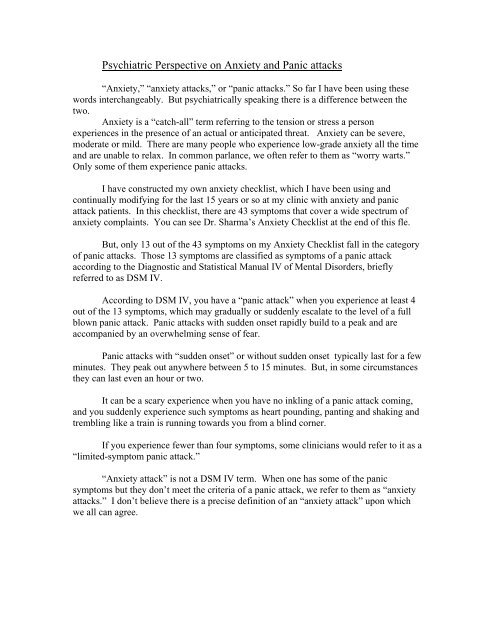Anxiety and Panic Attacks In Emphysema ... - Mind Publications
Anxiety and Panic Attacks In Emphysema ... - Mind Publications
Anxiety and Panic Attacks In Emphysema ... - Mind Publications
You also want an ePaper? Increase the reach of your titles
YUMPU automatically turns print PDFs into web optimized ePapers that Google loves.
Psychiatric Perspective on <strong>Anxiety</strong> <strong>and</strong> <strong>Panic</strong> attacks<br />
“<strong>Anxiety</strong>,” “anxiety attacks,” or “panic attacks.” So far I have been using these<br />
words interchangeably. But psychiatrically speaking there is a difference between the<br />
two.<br />
<strong>Anxiety</strong> is a “catch-all” term referring to the tension or stress a person<br />
experiences in the presence of an actual or anticipated threat. <strong>Anxiety</strong> can be severe,<br />
moderate or mild. There are many people who experience low-grade anxiety all the time<br />
<strong>and</strong> are unable to relax. <strong>In</strong> common parlance, we often refer to them as “worry warts.”<br />
Only some of them experience panic attacks.<br />
I have constructed my own anxiety checklist, which I have been using <strong>and</strong><br />
continually modifying for the last 15 years or so at my clinic with anxiety <strong>and</strong> panic<br />
attack patients. <strong>In</strong> this checklist, there are 43 symptoms that cover a wide spectrum of<br />
anxiety complaints. You can see Dr. Sharma’s <strong>Anxiety</strong> Checklist at the end of this fle.<br />
But, only 13 out of the 43 symptoms on my <strong>Anxiety</strong> Checklist fall in the category<br />
of panic attacks. Those 13 symptoms are classified as symptoms of a panic attack<br />
according to the Diagnostic <strong>and</strong> Statistical Manual IV of Mental Disorders, briefly<br />
referred to as DSM IV.<br />
According to DSM IV, you have a “panic attack” when you experience at least 4<br />
out of the 13 symptoms, which may gradually or suddenly escalate to the level of a full<br />
blown panic attack. <strong>Panic</strong> attacks with sudden onset rapidly build to a peak <strong>and</strong> are<br />
accompanied by an overwhelming sense of fear.<br />
<strong>Panic</strong> attacks with “sudden onset” or without sudden onset typically last for a few<br />
minutes. They peak out anywhere between 5 to 15 minutes. But, in some circumstances<br />
they can last even an hour or two.<br />
It can be a scary experience when you have no inkling of a panic attack coming,<br />
<strong>and</strong> you suddenly experience such symptoms as heart pounding, panting <strong>and</strong> shaking <strong>and</strong><br />
trembling like a train is running towards you from a blind corner.<br />
If you experience fewer than four symptoms, some clinicians would refer to it as a<br />
“limited-symptom panic attack.”<br />
“<strong>Anxiety</strong> attack” is not a DSM IV term. When one has some of the panic<br />
symptoms but they don’t meet the criteria of a panic attack, we refer to them as “anxiety<br />
attacks.” I don’t believe there is a precise definition of an “anxiety attack” upon which<br />
we all can agree.


